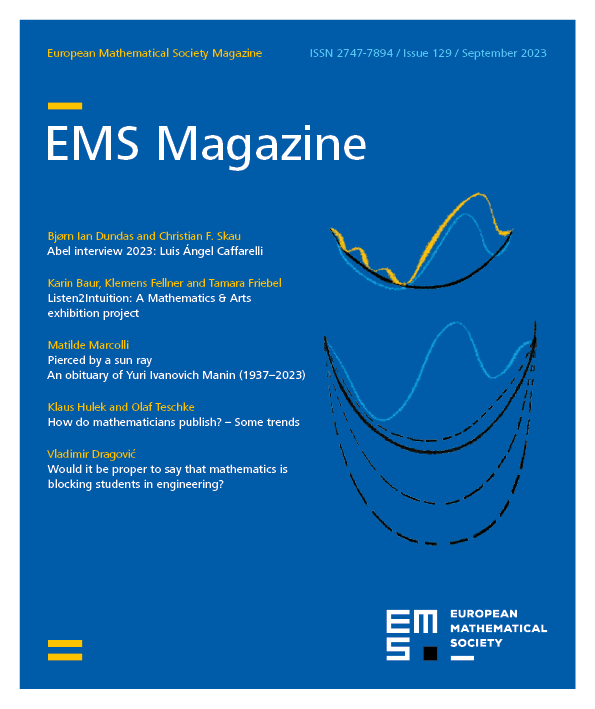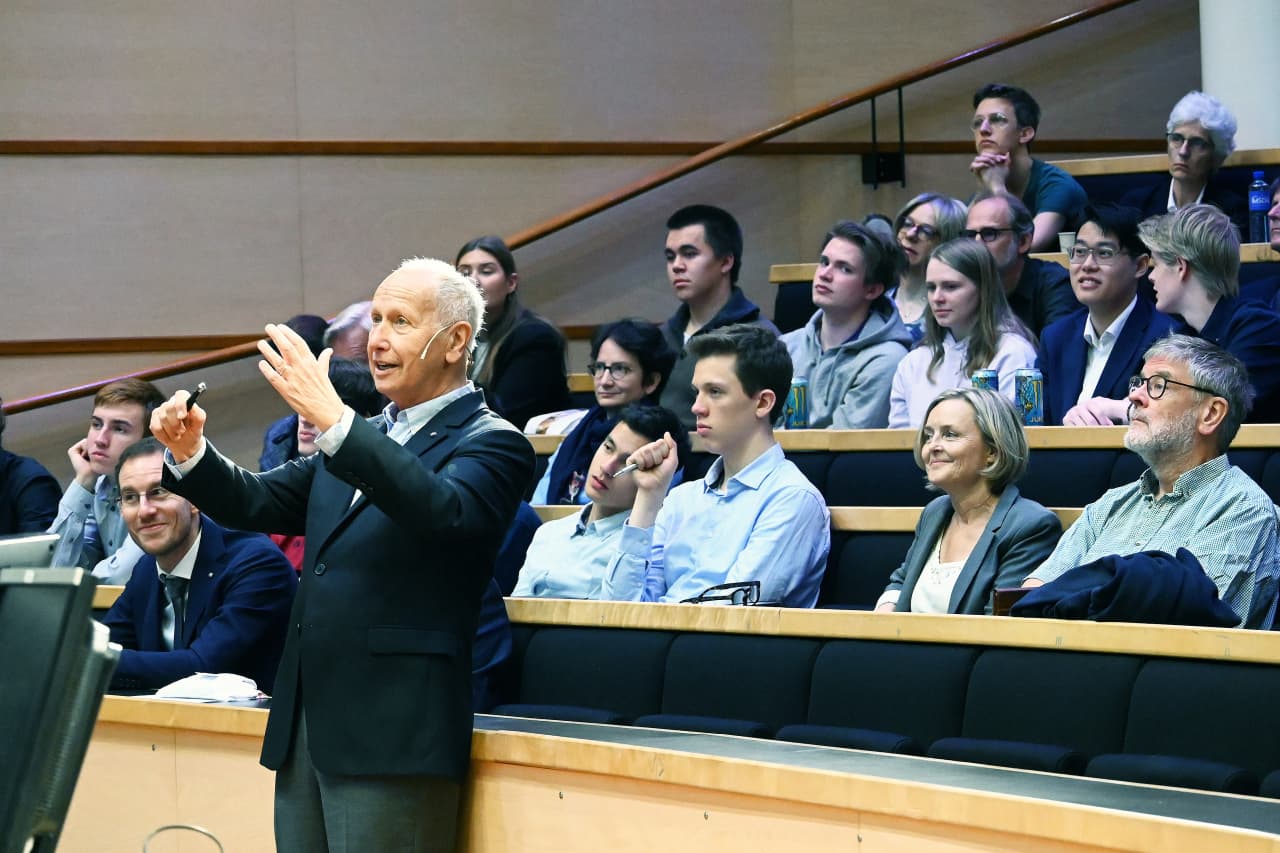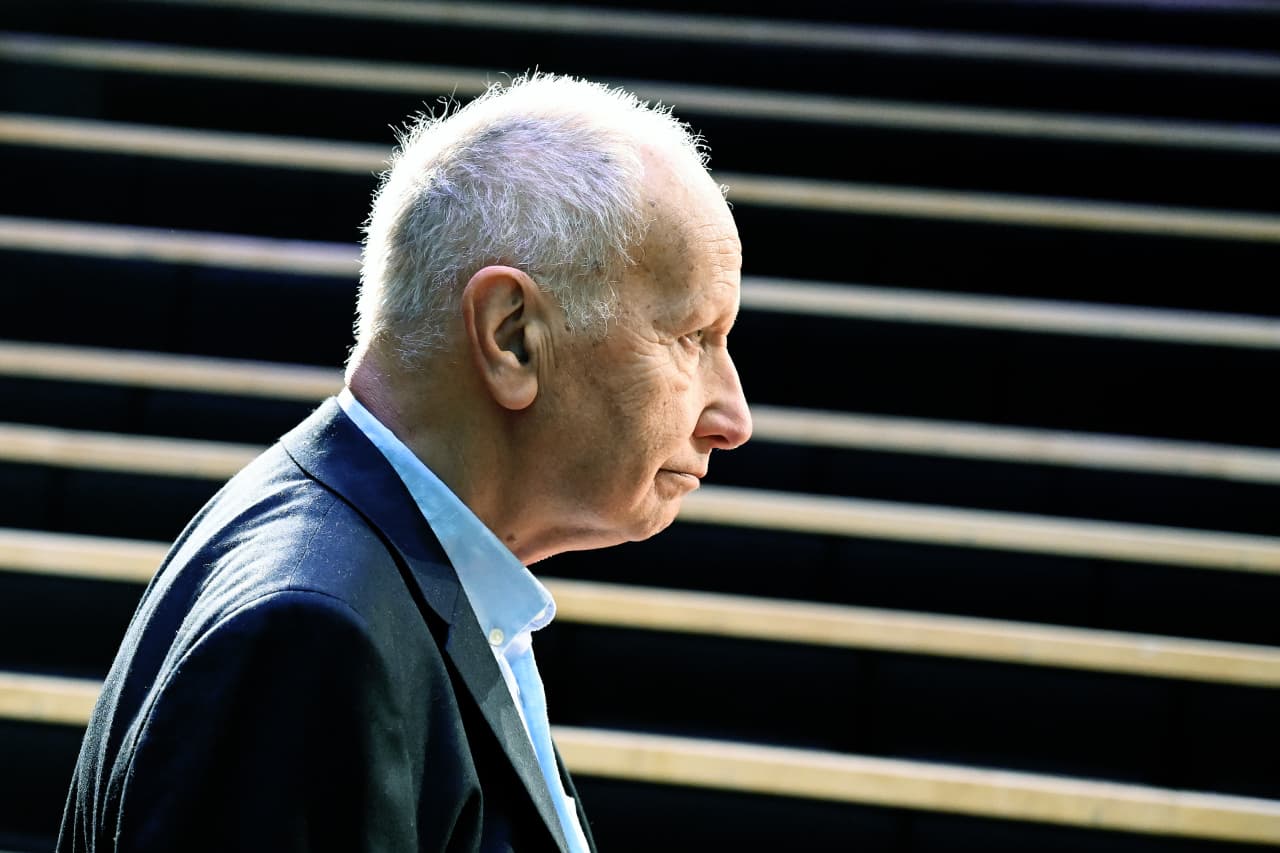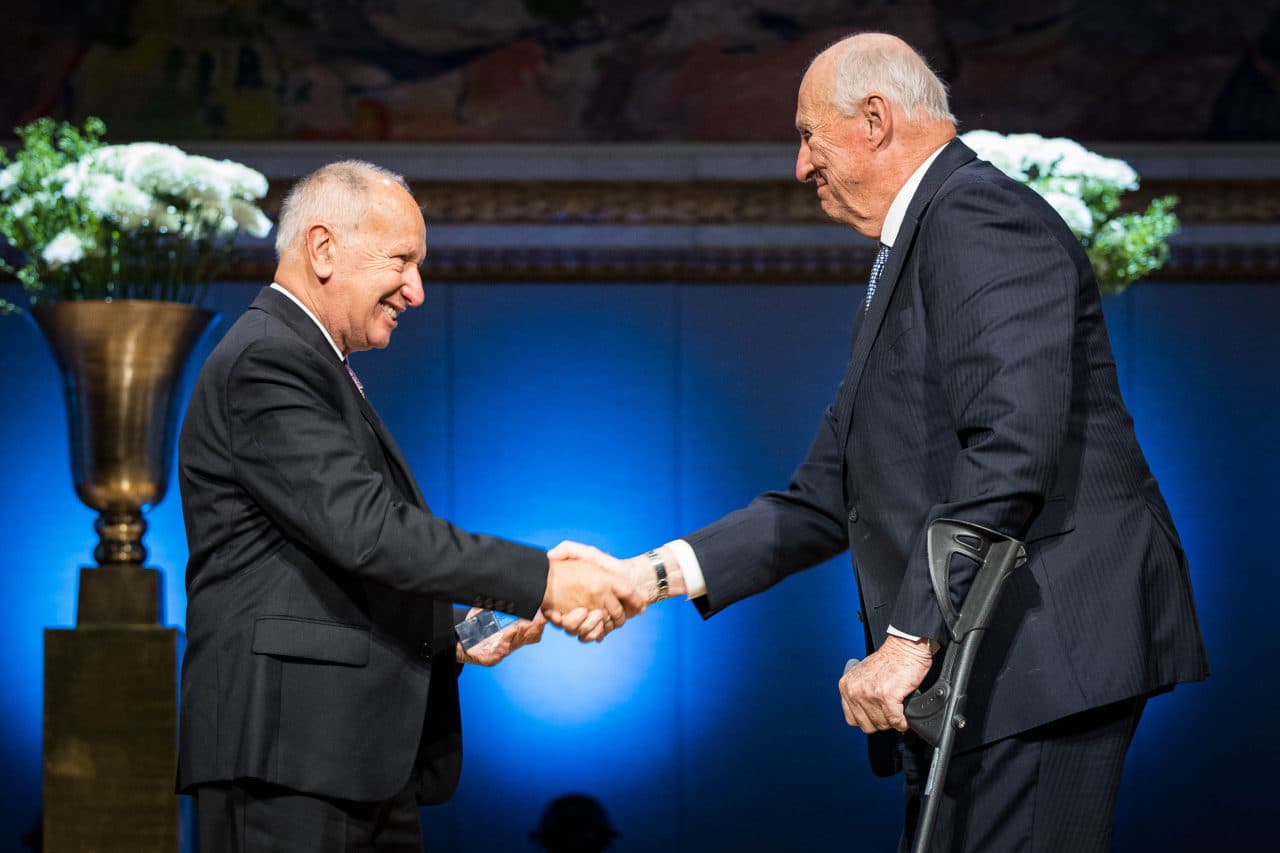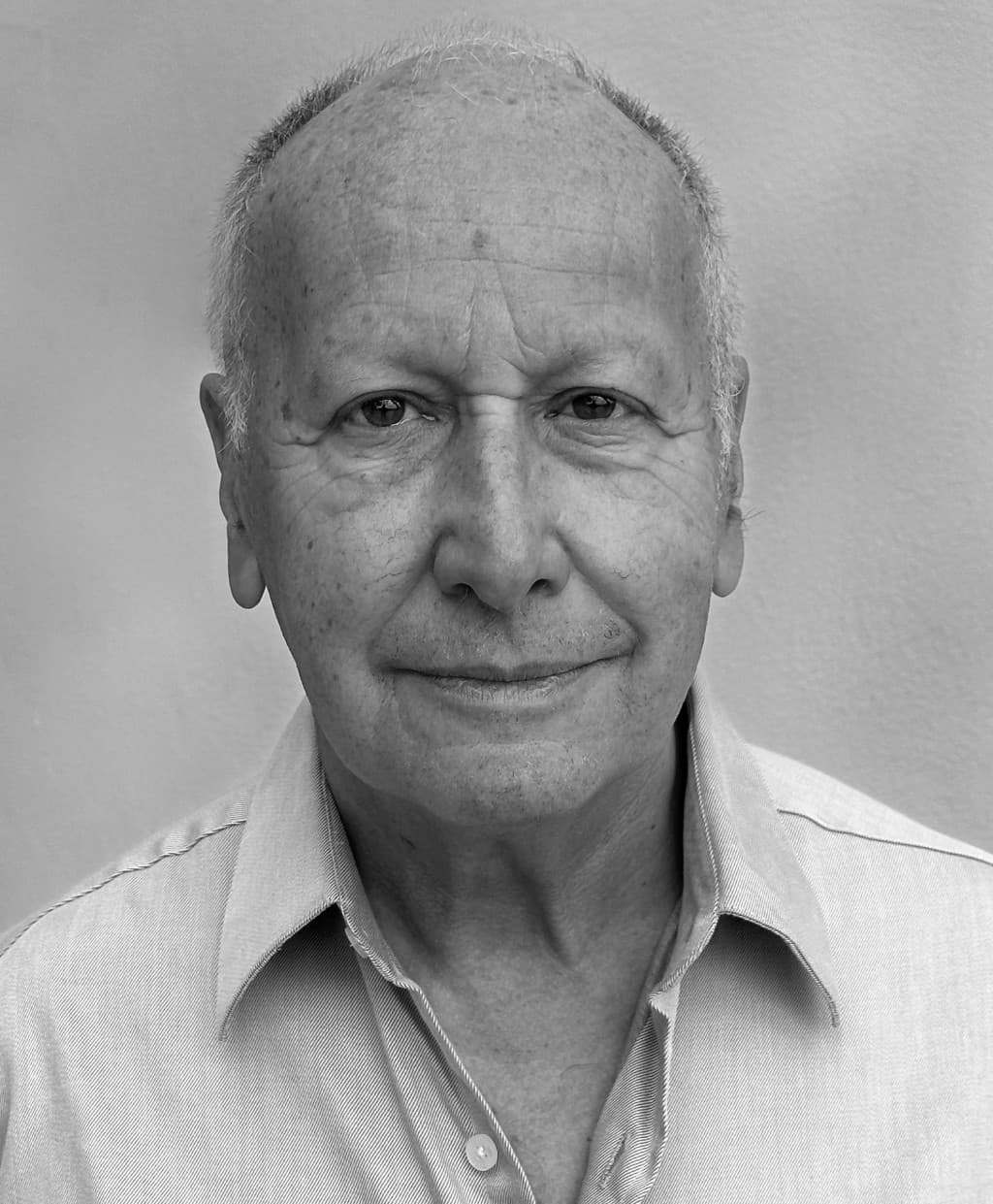Bjørn Ian Dundas/Christian F. Skau: Professor Caffarelli, firstly we want to congratulate you on being awarded the Abel Prize for 2023 for your “seminal contributions to regularity theory for nonlinear partial differential equations, including free boundary problems and the Monge–Ampère equation.” You will receive the prize tomorrow from His Majesty the King of Norway.
We will return to your mathematics, but first it might be a good idea to know something about your background. You were born in Buenos Aires in 1948. How would you describe your childhood?
Luis Ángel Caffarelli: We lived in a nice middle class area of Buenos Aires. At the time when I was a kid I would play soccer a lot with my friends. Another game we enjoyed a lot was to throw a ball, or something else, and see who got it closest to a wall or to a line.
The place where I lived was what I would characterize as an engineering area. My father was a mechanical engineer who worked in the shipping industry, assembling and repairing vessels for navigation in the Río de la Plata bay. When I was 16 years I joined him to assemble a ship engine. This is one of my warmest memories from my adolescence.
[BID/CFS]: So, your father was an inspiration to you?
LÁC: Yes, he was. He pushed me, with a lot of love, to do some serious things like engineering or science, or something like that. And I followed his advice. I was admitted to a renowned secondary school, Colegio Nacional de Buenos Aires, run by the University of Buenos Aires. There my scientific interests were channeled by inspiring teachers towards physics and mathematics. I graduated from high school in 1966, and I joined the University of Buenos Aires in March 1967, majoring in physics and mathematics. I received my undergraduate degree in 1970.
As a student I was heavily influenced and inspired by Luis Santaló [1911–2001], Manuel Balanzat [1912–1994] and Carlos Segovia [1937–2007]. Santaló and Balanzat were both Spanish mathematicians who moved to Argentina as a consequence of the Spanish Civil War. Santaló made important contributions to integral geometry and geometric probability, while Balanzat worked in functional analysis. They built, jointly with Rey Pastor [1888–1962] and Pi Calleja [1907–1986], a superb undergraduate and graduate mathematics program at the University of Buenos Aires, generating a very strong group in analysis, geometry and algebraic geometry.
The harmonic analyst Segovia was a prominent graduate from Universidad de Buenos Aires who did his PhD at the University of Chicago in 1967 with Alberto Calderón [1920–1988]. While closer to me in age than Santaló and Balanzat, Segovia was always a strong support.
Abel laureate Luis Caffarelli giving his lecture at the University of Oslo, 2023.
©Ola G. Sæther / The Abel Prize
[BID/CFS]: You then embarked on your graduate studies, receiving your PhD in mathematics in 1972. Your PhD advisor was Calixto Calderón [1939–], the stepbrother of the much older and very famous mathematician Alberto Calderón you mention. Tell us about your graduate work.
LÁC: Calixto Calderón steered my imagination towards special function theory, which was a vibrant subject associated with finding optimal representations to solutions of partial differential equations (PDEs) by analytic methods consisting of series representations of special polynomial forms. A key point of my thesis involves Abel summability techniques, which I find fascinating considering I am being honored by receiving the Abel Prize! In fact, one of the papers I published with Calixto Calderón in 1974, in the wake of my thesis work, is titled: “On Abel summability of multiple Jacobi series.”
Luis Caffarelli Abel Prize laureate 2023.
©Ola G. Sæther / The Abel Prize
[BID/CFS]: May we interject a remark here which, at least tangentially, is related to this? In 2007 you published, together with your former PhD student Luis Silvestre [1977–], the enormously influential paper “An extension problem related to the fractional Laplacian.” Historically, Abel [1802–1829] was the first to introduce fractional derivation and integration (he effectively used it to solve the generalized isochrone problem – a problem that goes back to Christiaan Huygens [1629–1695]). So broadly speaking, some key notions in your work can be traced back to Abel.
LÁC: Well, that’s why we are here!
Early career and free boundary problems
[BID/CFS]: After obtaining your PhD at the University of Buenos Aires you went to the University of Minnesota as a post-doc, arriving there in January 1973. What made you choose to go there?
LÁC: There was a connection established earlier between the mathematics departments at the University of Buenos Aires and the University of Minnesota, so it was quite natural for me to go there as a post-doc student. Also, my PhD advisor Calixto Calderón had arrived there already in 1972, having been offered a permanent position. However, he left the University of Minnesota in the fall of 1974 to take up a tenured position at the University of Illinois at Chicago.
I found my colleagues at the mathematics department at the University of Minnesota to be friendly, extremely generous and dedicated, and they taught me much of what I know. They shared their ideas and gave me guidance as I began my research program.
[BID/CFS]: Was there some person in particular that was important for your mathematical research while at the University of Minnesota?
LÁC: Yes, upon arrival I met Hans Lewy [1904–1988]. He was an extraordinary analyst working on nonlinear PDEs and minimal surfaces. I attended a lecture series on harmonic analysis given by Lewy. He gave me two problems, which I succeeded in solving in a few months. Having his support was a game changer for me, influencing strongly my career path. One of the problems Lewy suggested was the obstacle problem, which is an example of what is known as a free boundary problem.
[BID/CFS]: In 1977 you published a paper titled “The regularity of free boundaries in higher dimensions” in the prestigious journal Acta Mathematica. You surprised the mathematical world with this paper, a work whose novelty and brilliance was the basis of your future fame. You were the first mathematician to really understand the free boundary problem in more than one dimension. Furthermore, the methods that you introduced have been extremely powerful and are still being used in many other problems. Could you elaborate on all this?
LÁC: Melting ice is an example of a free boundary problem, the free boundary being the surface between ice and water. The surface shifts as ice melts.
Another example of this type of a problem would be a balloon inside a box (or a drop inside a cavity). If the balloon is suspended in the air without constraints, a first approximation to its shape is given by a prescribed mean curvature equation – a mildly nonlinear PDE that we can deduce from the fact that the balloon tries to minimize the energy of the configuration. If constrained to lie inside the box, the surface of the balloon will behave differently depending on whether it presses against the wall or not, giving rise to a strongly nonlinear PDE. The separation curve between the different regions is called the free boundary. In this area I have investigated extensively the mathematical problems associated with solid-liquid interfaces, jet and cavitational flows, and gas and liquid flow in porous media.
The Navier–Stokes and Monge–Ampère equations
[BID/CFS]: Let us put things in perspective. The early 1960s saw great developments in the theory of linear PDEs, where a PDE is called linear if it is linear in the unknown and its derivatives. Many people contributed to this, but the deepest and most significant results were due to Lars Hörmander [1931–2012], according to the citation when he received the Fields Medal in 1962. It is worth noting, though, that some results obtained in the 1950s by Alberto Calderón were very important for this development.
The upshot of all this is that for linear PDEs there exists a theory. This contrasts with what is the case for nonlinear PDEs, where it is usually acknowledged that there is no “general” theory, with specialist knowledge being somewhat divided between several essentially distinct subfields. PDEs, and in particular, nonlinear PDEs, are ubiquitous in physics, ranging from gravitation to fluid dynamics. They also are important in mathematics, and have been used to solve problems such as the Poincaré conjecture and the Calabi conjecture.
Many of the fundamental PDEs in physics, such as the Einstein equations of general relativity and the Navier–Stokes equations, are quasilinear (meaning that the highest-order derivatives appear only as linear terms, but with coefficients possibly functions of the unknown and lower-order derivatives). On the other hand, the Monge–Ampère equation, which we shall return to and which arises in differential geometry, is fully nonlinear, meaning that it possesses nonlinearity in one or more of the highest-order derivatives.
Among the many open questions are the existence and regularity of solutions to the Navier–Stokes equations, named as one of the Millennium Prize Problems of the Clay Foundation in 2000. Tell us about your involvement with the Navier–Stokes equations.
Illustrations created by Luis Ángel Caffarelli (published with his explicit permission)
©Luis Ángel Caffarelli
LÁC: In 1980 Louis Nirenberg [1926–2020], Abel Prize recipient in 2015 (a prize he shared with John Nash, Jr. [1928–2015]) invited me to join the Courant Institute at NYU as a full professor. This experience was a game changer with respect to my academic research. Nirenberg steered my interest towards fluid dynamics and fully nonlinear equations. Walking one day in Chinatown with Nirenberg and Robert Kohn [1953–], we decided to work together on a paper about the Navier–Stokes equations, a set of nonlinear PDEs that models the evolution of viscous incompressible fluid flows (in dimension three).
The result of this “CKN” collaboration was the 1982 paper titled, “Partial regularity of suitable weak solutions of the Navier–Stokes equations.” We showed that the flow had singularities at most on a set of zero one-dimensional measure (i.e., less than a curve) in space and time. This is a nearly optimal result according to examples given by Vladimir Scheffer [1950–2023].
A more technical way to state the CKN theorem is the following: Let be a weak solution of the Navier–Stokes equations for incompressible fluids, satisfying suitable growth conditions. (To arrive at the idea of a weak solution of a PDE, one integrates the equation against a test function, and then integrates by parts (formally) to apply the derivatives on the test function.) The result says that is regular away from a closed set whose one-dimensional parabolic Hausdorff measure is zero.
This is the best partial regularity theorem known so far for the Navier–Stokes equations. It appears to be very hard to go further; we need some deep, new ideas.
[BID/CFS]: Nirenberg has said that you had a “fantastic intuition,” which made it hard for collaborators to keep up with you: “He somehow immediately sees things other people don’t see, but he has trouble explaining them,” Nirenberg said.
Let us move on to the Monge–Ampère equation, on which you have made seminal contributions, especially on their regularity properties, i.e., high order differentiability. The Monge–Ampère equation is a fully nonlinear PDE that frequently arises in differential geometry; for example, it is used to construct surfaces of prescribed Gaussian curvature. How did you get started to work on the Monge–Ampère equation and, more generally, on fully nonlinear equations?
His Majesty King Harald V presents the 2023 Abel Prize to Luis Caffarelli.
©Alf Simensen – NTB / The Abel Prize
LÁC: While at Courant, I listened to a talk of Pierre-Louis Lions [1956–], who left an open question on this problem. I was able to solve it by using ideas from free boundary theory, thus finding a connection between two different parts of PDEs. Then I started to work with Nirenberg and Joel Spruck [1946–], and we published several papers together on the Monge–Ampère equation, including one paper on the complex Monge–Ampère equation (together with Kohn).
These papers, published between 1984 and 1986, were among the first to develop a general theory of second-order elliptic differential equations which are fully nonlinear, with a regularity theory that extends to the boundary. It should be remarked that the paper from 1985, published in Acta Mathematica and titled “The Dirichlet problem for nonlinear second-order elliptic equations III. Functions of the eigenvalues of the Hessian” has been particularly influential in the field of geometric analysis, since many geometric PDEs are amenable to its methods.
[BID/CFS]: Over several decades you wrote many papers, often with co-authors, which have “Monge–Ampère equation” in their titles. It is especially noteworthy that your regularity theorems from the 1990s represented a major breakthrough in the understanding of the Monge–Ampère equation. In particular, according to the Abel Prize citation you “closed the gap in the understanding of singularities by proving that the explicitly known examples of singular solutions are the only ones.”
The fractional Laplacian
Now let’s move on to a more recent paper of yours from 2007 (co-authored with Luis Silvestre), a paper we alluded to above, and which is titled “An extension problem related to the fractional Laplacian.” The paper is 15 pages long, but had an enormous impact in many different subfields of PDEs. It is also your most cited paper, with more than 1600 citations on MathSciNet! Tell us about this paper.
LÁC: Without getting too technical, let me try to explain the main idea, as well as some results, of this paper. The Laplacian is the second-order differential operation . On the fractional Laplacian , for a real number between and , is perhaps easiest understood by means of its Fourier transform, where differentiating corresponds to multiplication with the norm of the variable. So, a fractional Laplacian is mirrored in the Fourier transform by multiplication by the norm of the variable to the appropriate power. Another way to define the fractional Laplacian is via the formula
where is a function and is a normalizing constant.
The main idea of the paper is proving a result which relates a nonlocal problem associated to the fractional power of the Laplacian to a local degenerate elliptic problem.
This allows us to prove several regularity results concerning the solutions of problems involving the Laplacian by exploiting purely local techniques. In particular, we prove both a Harnack inequality and a boundary Harnack inequality.
Work style, students and more recent research
[BID/CFS]: As a mathematician, you are extraordinarily prolific – and extraordinarily sociable. You have published more than 320 papers, you have co-written papers with more than 130 people and advised more than 30 PhD students. Do you have any comments on this?
LÁC: Through the years, I have had the opportunity to belong to wonderful institutions, starting with the University of Buenos Aires, and then the University of Minnesota, the Courant Institute, NYU, the University of Chicago, the Institute for Advanced Study, Princeton, and for the last 26 years, the University of Texas at Austin.
This gave me the opportunity to befriend and collaborate with extraordinary scientists all over the world. It also led to further opportunities to mentor very talented young people who have invigorated my research with new ideas. I have moved between topics within the wider field of PDEs. There are people who do wonderful things in very concentrated areas. But science is more like a global evolution. It requires the exchange of ideas, looking at things from different angles, slowly improving whatever can be improved.
[BID/CFS]: Are you more of a problem solver than a theory builder?
LÁC: Yes, definitely. Broadly speaking, there are two kinds of mathematicians. There are those who develop theories and those who are primarily problem solvers. I belong to the latter group.
[BID/CFS]: As you told us, you have spent the last 26 years at the University of Texas at Austin. Your wife Irene Martínez Gamba, who is also a mathematician, is professor of computational engineering and sciences at the same university. You have had more than 20 graduate students while at the University of Texas. Tell us about your research activity there.
LÁC: My research expanded in an immense way due to the fact that I had graduate students again; many of them I still have long-lasting collaborations with. I am indebted to all of them. Of specific research topics I worked on, I would list three:
Free boundaries in (Lipschitz) surface detection.
Problems with fractional diffusion; a completely new theory that filled my agenda for many years.
I kept on working on the Monge–Ampère equation and its regularity theory in fully nonlinear configurations.
I would also mention that I interacted with a group of engineers and natural scientists. I enjoyed enormously having discussions with them, as they somehow relied on some of my ideas.
[BID/CFS]: We always end these interviews by asking about interests outside of mathematics. Do you have any special interests or hobbies?
LÁC: I like to cook, but my wife is a better chef than I am. I also like to play some soccer if I have time. I play the piano. I prefer mostly classical music.
Luis Caffarelli, Abel Prize laureate 2023.
©Peter Badge / The Abel Prize
[BID/CFS]: On behalf of the Norwegian Mathematical Society, the European Mathematical Society and the two of us, we would like to thank you for this interesting interview.
LÁC: Thank you very much.
Cite this article
Bjørn Ian Dundas, Christian F. Skau, Abel interview 2023: Luis Ángel Caffarelli. Eur. Math. Soc. Mag. 129 (2023), pp. 20–24
DOI 10.4171/MAG/158